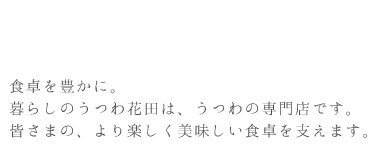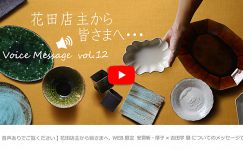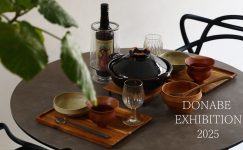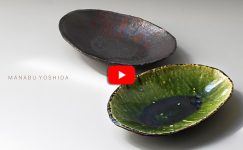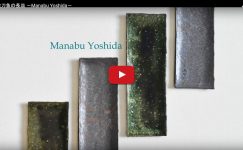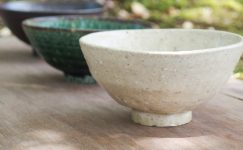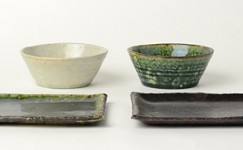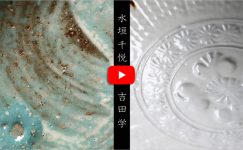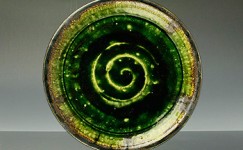English version of the interview here.
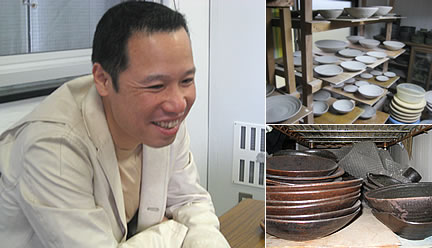
“Original, Self-Taught, Creative” – Manabu Yoshida
Hanada: How did you start making tableware in the first place…
Manabu Yoshida: The company I worked for went bankrupt. But I had always loved fishing, and I wanted to serve the fish I caught on tableware I made myself. It wasn’t a happy situation, but the company’s bankruptcy gave me a kind of push. Since it was almost a forced situation, I entered this world without having to make a bold decision on my own. Looking back now, I think it worked out well.
Hanada: Normally, you would apprentice somewhere, learn the basics, and so on.
Manabu Yoshida: That wasn’t the case for me. I had an acquaintance who knew a lot, so I just asked, “Excuse me, where can I buy a kiln for pottery?”
Hanada: That’s not something anyone can do—starting like that. What about the potter’s wheel?
Manabu Yoshida: I bought a manual wheel myself. But at the time, I had no money, and I didn’t want to buy an electric wheel. So I went to a “one-day pottery experience” class, where you can try an electric wheel for a low price. It was only about two hours.
Hanada: That’s bold (laughs). A trial class… doesn’t sound like the plan of someone planning to make a living from pottery.
Manabu Yoshida: After that, I spent a year studying on my own. It was full of trial and error, and yes, it was lonely and stressful. Both my mental and physical energy were pushed to the limit, so it was tough.
Hanada: The answer you arrived at then is your current style, right?
Manabu Yoshida: From the beginning, I wanted to make casual tableware that balanced strength and warmth. I never wavered in that intention. I spent a year exploring methods to realize it. Looking back, it was a valuable time.
Hanada: And then you visited Hanada with your samples. That was six years ago.
Manabu Yoshida: When I got orders, I thought, “Yes, what I’ve been doing isn’t wrong.” It was truly gratifying.
Hanada: You’re a precious presence for Hanada too. Your tableware has a unique atmosphere. Whether it’s Oribe, iron glaze, or this silver finish, each has a distinct charm. It’s the allure of handmade work.
Manabu Yoshida: Yes. Since I created them independently, the effort I put in made them something only I could do. So I don’t compare my work to others’ tableware, nor could I (laughs). Of course, there are many who are more skilled than me, so seeing their work is always instructive.
Hanada: Your tableware is original, but not difficult to use.
Manabu Yoshida: My basic principle is that you can imagine the dish just by looking at the tableware. And it has to be something I want to use myself.
Hanada: I see. Your tableware’s uses expand naturally once you start using it. It’s easy to plate dishes, and you notice all the functional considerations like ease of holding. I hear you put a lot of thought into the plate for the May exhibition too.
Manabu Yoshida: Exactly. It can be used reversibly and is easy to hold. When planning tableware, I imagine as if I were the chef (laughs). The food is the star. When the table looks lively and enjoyable, it feels like life itself becomes richer.
Hanada: If I say too much, it might lessen its value, but the strength and warmth of your work comes from the effort coil-building requires, right?
Manabu Yoshida: Not because someone told me, but in terms of time, it takes more than five times as long as wheel forming. For this silver finish (tried for the May exhibition), I sand each piece individually. But I cannot rely on the effort alone. Ultimately, it’s about whether the finished piece is good or not.
Hanada: What is this collection’s theme?
Manabu Yoshida: “Special Meals.” Actually, since I got the exhibition offer, I’ve imagined it very concretely.
Hanada: What do you mean?
Manabu Yoshida: This platter for flounder marinated in kelp, the Oribe plate for simmered scorpionfish, the Oribe long rectangular plate for mackerel sushi, the square bowl for white fish cake, the free cup for brown sugar shochu.
Hanada: Very specific (laughs). Your “tableware made for yourself” is literally “tableware you want to use yourself.”
Manabu Yoshida: Exactly. Always, but especially this time.
Hanada: Seeing the samples makes me look forward to using them. This platter would make pickles look beautiful if you reversed it. By the way… this free cup shows you really love drinking, don’t you?
Manabu Yoshida: I do (laughs).

「独自、独学、独創」 吉田学
花田:そもそも吉田さんがうつわづくりを始めたのは…
吉田:勤めていた会社が倒産してしまったんです。
でも、元々釣りが好きで釣った魚を自分で作ったうつわに盛りつけたいな、なんていう思いはありました。
決して嬉しくはなかったけど、会社の倒産は、ひとつのきっかけです。
半ば強制的な状況なので、自ら思い切った踏ん切りをつけることなく、この世界に入ってきました。
今思えばよかったんじゃないかな、と思います。
花田:で、普通ならどこかに弟子入りをして、基本を学んで、となるところですが。
吉田:僕の場合はそうではありませんでした。
知り合いに詳しい人がいたので「すみません、やきものの窯ってどこで買うんですか」って。
花田:誰にでも出来ることじゃないですね、その始め方。ろくろなどはどうしたのでしょうか?
吉田:手回しろくろは自分で買ってきました。でも当時お金もないし、電動ろくろ買うのは嫌だな、と。
で、「一日やきもの体験教室」に行きました。そこなら電動ろくろを安くで体験できる。
二時間くらいでした。
花田:大胆すぎます(笑)。
体験教室って・・・これからうつわで生計立てていこうってひとの発想じゃないです。
吉田:その後は独自に一年間研究を重ねました。
試行錯誤の連続で、孤独だし不安だったのは事実で、
気力も体力もギリギリのところまで来ていたし、そりゃ大変でした。
花田:出てきた答えが、今のスタイルですね。
吉田:元々、力強さと温かさを両立させたカジュアルなうつわを作りたかったんです。
そこに迷いはありませんでした。
一年間、その実現のための方法論を模索していたわけで、
今思えば、貴重な時間でした。
花田:それで見本を持って花田に訪問してくれるのですね。あれから六年経ちます。
吉田:注文出た時には「よし、やっていることは間違っていない」と。本当にうれしかったです。
花田:花田にとっても、貴重な存在です。
吉田さんのうつわは他にない雰囲気を持っています。
織部にしたって、鉄釉にしたって、この銀化にしたって独特の味わいがあります。
手作りゆえの魅力が詰まっています。
吉田:そうですね。
独自に作り上げたものであるので、苦労した分、自分にしかできないものになったと思っています。
だから、自分のものを他の作者さんのうつわと比べることもないし、比べようもないんです(笑)。
もちろん、僕より上手い人はたくさんいるだろうから、いろいろ見せてもらうことは勉強になります。
花田:吉田さんのうつわは独自ですが、使いづらいわけではありません。
吉田:僕の中での基本原則は、うつわを見て料理が想像できること。
そして、自分が使いたいもの、です。
花田:なるほど。
吉田さんのうつわは使い始めてから用途がぐんぐん広がっていきます。
盛りつけやすいですし。
使っていると、持ちやすさなどの機能の点も実は色々工夫していることに気づかされます。
この5月企画展用の台皿も色々考えられたようですね。
吉田:そうそう、リバーシブルでも使えるし、持ちやすいですよ。
うつわの構想を練る際は、一応料理人にでもなったつもりで色々と想像します(笑)。
やっぱり料理が主役。
自分自身、食卓が華やいだり、楽しかったりすると、暮らしそのものが豊かになっていく気がします。
花田:ここをあまり言ってしまうと、却って価値の無いものになってしまいそうですが、
吉田さんのうつわが持つ力強さ、暖かさはやはり、
紐づくりが要する手間に支えられているんだと思います。
吉田:言われたからじゃないけど、時間でいえば轆轤成形の5倍以上、
この銀化(5月の企画展用に新たに試みてくれています)は
一枚一枚銀化用のサンドペーパーをかけています。
ただ、その手間の量に甘えるわけにはいかない。
やはり「できたものが良いか、悪いか」です。
花田:今回のテーマはなんでしょうか?
吉田:「とっておきの食事」。
実は、企画展の話をいただいてから、具体的すぎるくらい具体的に想像していたんです。
花田:どういうことですか?
吉田:この台皿はヒラメの昆布じめ、織部の皿はかさごの煮付け、
織部の長角皿は鯖寿司、四方鉢はしんじょう、フリーカップは黒糖焼酎。
花田:具体的ですね(笑)。吉田さんにとっての「自分のためにつくるうつわ」は
まさに「自分で使いたいうつわ」ですね。
吉田: まさしく。いつもそうですけど、今回は特に。
花田:見本を見ていると、使うのが楽しみになってきます。
この台皿はひっくり返して漬物を盛りつけても野菜の色が映えそうです。
それにしても…このフリーカップ見ていて感じるんですが、お酒ほんとうに好きでしょう・・・。
吉田:好きです(笑)。





